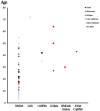Characteristics of Seizure and Antiepileptic Drug Utilization in Outpatients With Autoimmune Encephalitis
- PMID: 30671012
- PMCID: PMC6331521
- DOI: 10.3389/fneur.2018.01136
Characteristics of Seizure and Antiepileptic Drug Utilization in Outpatients With Autoimmune Encephalitis
Abstract
Autoimmune encephalitis (AE) is one kind of encephalitis that associates with specific neuronal antigens. Most patients with AE likely suffer from seizures, but data on the characteristics of seizure and antiepileptic drugs (AEDs) utilization in this patient group remains limited. This study aimed to report the clinical status of seizure and AEDs treatment of patients with AE, and to evaluate the relationship between AEDs discontinuation and seizure outcomes. Patients with acute neurological disorders and anti-N-methyl-D-aspartate receptor (NMDAR), γ-aminobutyric acid B receptor (GABABR), leucine-rich glioma inactivated 1, or contactin-associated protein-like 2 (CASPR2) antibodies were included. As patients withdrew from AEDs, they were divided into the early withdrawal (EW, AEDs used ≤3 months) and late withdrawal (LW, AEDs used >3 months) groups. Seizure remission was defined as having no seizures for at least 1 year after the last time when AEDs were administered. Seizure outcomes were assessed on the basis of remission rate. The factors affecting the outcomes were assessed through Spearman analysis. In total, we enrolled 75 patients (39 patients aged <16 years, male/female = 39/36) for follow-up, which included 67 patients with anti-NMDAR encephalitis, 4 patients with anti-GABABR encephalitis, 2 patients with anti-voltage-gated potassium channel encephalitis, and 2 patients with coexisting antibodies. Among the 34 enrolled patients with anti-NMDAR encephalitis who were withdrawn from AEDs, only 5.8% relapse was reported during the 1-year follow-up, with no significant difference in the percentage of relapse between the EW and LW groups (P = 0.313). Fifteen patients (an average age of 6.8, 14 patients with anti-NMDAR encephalitis and 1 patient with anti-CASPR2 encephalitis) presented seizure remission without any AEDs. Seventy five percent of patients with anti-GABABR antibodies developed refractory seizure. Other risk factors which contributed to refractory seizure and seizure relapse included status epilepticus (P = 0.004) and cortical abnormalities (P = 0.028). Given this retrospective data, patients with AE have a high rate of seizure remission, and the long-term use of AEDs may not be necessary to control the seizure. Moreover, seizures in young patients with anti-NMDAR encephalitis presents self-limited. Patients with anti-GABABR antibody, status epilepticus, and cortical abnormalities are more likely to develop refractory seizure or seizure relapse.
Keywords: antiepileptic drug withdrawal; autoimmune encephalitis; outpatients; refractory seizure; seizure remission.
Figures



Similar articles
-
Clinical features and long-term outcomes of seizures associated with autoimmune encephalitis: A follow-up study in East China.J Clin Neurosci. 2019 Oct;68:73-79. doi: 10.1016/j.jocn.2019.07.049. Epub 2019 Jul 19. J Clin Neurosci. 2019. PMID: 31331752
-
Clinical and Electroencephalographic Features of the Seizures in Neuronal Surface Antibody-Associated Autoimmune Encephalitis.Front Neurol. 2020 May 5;11:280. doi: 10.3389/fneur.2020.00280. eCollection 2020. Front Neurol. 2020. PMID: 32431657 Free PMC article.
-
Long-term seizure outcomes in patients with autoimmune encephalitis: A prospective observational registry study update.Epilepsia. 2022 Jul;63(7):1812-1821. doi: 10.1111/epi.17245. Epub 2022 Apr 16. Epilepsia. 2022. PMID: 35357695
-
Use of anti-seizure medications in different types of autoimmune encephalitis: A narrative review.Front Neurol. 2023 Mar 23;14:1111384. doi: 10.3389/fneur.2023.1111384. eCollection 2023. Front Neurol. 2023. PMID: 37034075 Free PMC article. Review.
-
Typical clinical and imaging manifestations of encephalitis with anti-γ-aminobutyric acid B receptor antibodies: clinical experience and a literature review.Neurol Sci. 2019 Apr;40(4):769-777. doi: 10.1007/s10072-018-3679-5. Epub 2019 Jan 22. Neurol Sci. 2019. PMID: 30671737 Review.
Cited by
-
Seizures and risk of epilepsy in anti-NMDAR, anti-LGI1, and anti-GABAB R encephalitis.Ann Clin Transl Neurol. 2020 Aug;7(8):1392-1399. doi: 10.1002/acn3.51137. Epub 2020 Jul 25. Ann Clin Transl Neurol. 2020. PMID: 32710704 Free PMC article.
-
Acute Symptomatic Seizures and Risk of Seizure Recurrence in Patients with Anti-NMDAR, Anti-LGI1, and Anti-GABABR Encephalitis.Neurol Sci. 2024 Apr;45(4):1609-1617. doi: 10.1007/s10072-023-07165-1. Epub 2023 Nov 9. Neurol Sci. 2024. PMID: 37940748
-
Early Prediction of Epilepsy after Encephalitis in Childhood Based on EEG and Clinical Features.Emerg Med Int. 2023 Jul 13;2023:8862598. doi: 10.1155/2023/8862598. eCollection 2023. Emerg Med Int. 2023. PMID: 37485251 Free PMC article.
-
Prognostic factors underlying the development of drug-resistant epilepsy in patients with autoimmune encephalitis: a retrospective cohort study.J Neurol. 2024 Aug;271(8):5046-5054. doi: 10.1007/s00415-024-12432-y. Epub 2024 May 27. J Neurol. 2024. PMID: 38801431
-
Acute Symptomatic Seizures and Risk of Epilepsy in Autoimmune Encephalitis: A Retrospective Cohort Study.Front Immunol. 2022 Feb 23;13:813174. doi: 10.3389/fimmu.2022.813174. eCollection 2022. Front Immunol. 2022. PMID: 35281052 Free PMC article.
References
-
- Irani SR, Bera K, Waters P, Zuliani L, Maxwell S, Zandi MS, et al. . N-methyl-D-aspartate antibody encephalitis: temporal progression of clinical and paraclinical observations in a predominantly non-paraneoplastic disorder of both sexes. Brain (2010) 133 (Pt 6):1655–67. 10.1093/brain/awq113 - DOI - PMC - PubMed
LinkOut - more resources
Full Text Sources
Research Materials

